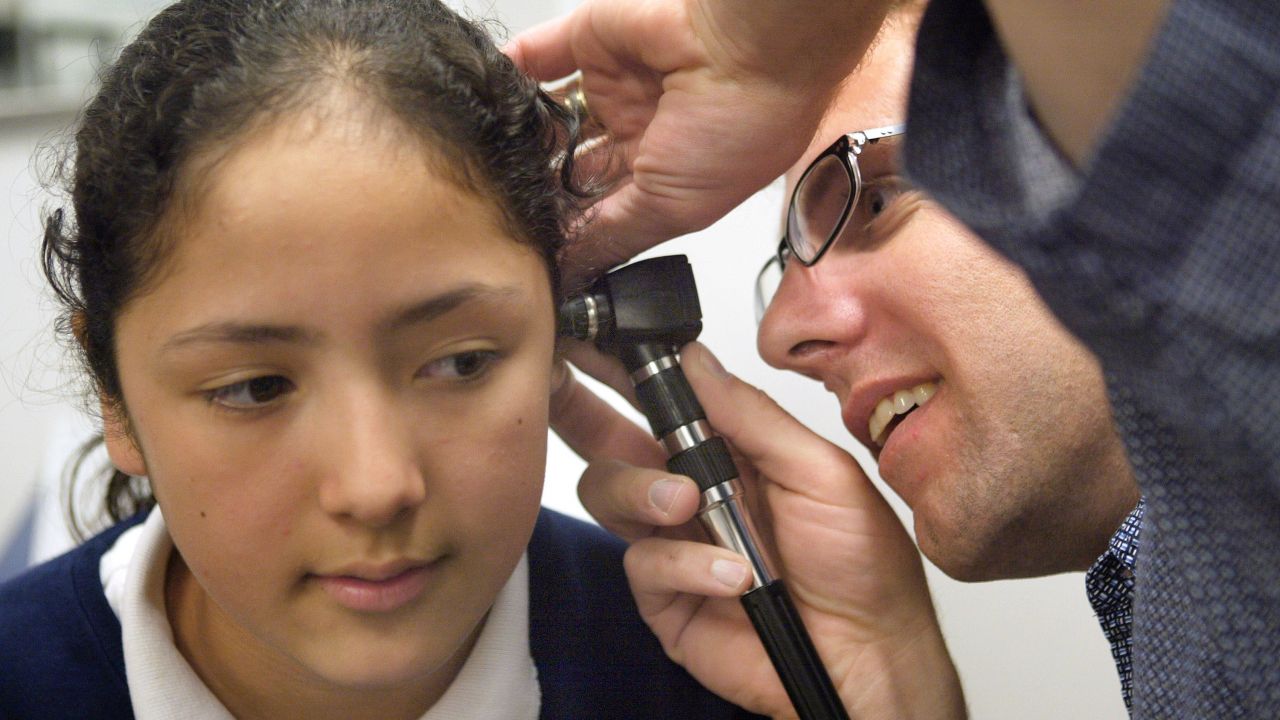
Dr. Michael Paul, with the Pediatric Mobile Health Unit of Loyola University Medical Center, performs a physical exam on fourth-grader Bennita Correa outside David Burnham Elementary School on May 11, 2004 in Cicero, Illinois. The Pediatric Mobile Health Unit, is a 40-foot long truck which accommodates two patient examination rooms, a laboratory, a medical records area and hearing booth. Since 1998 more than 50,000 uninsured and underinsured children in the Chicago area have been evaluated and treated at the unit. (Photo by Tim Boyle/Getty Images)
This post originally appeared at The Conversation.
Since the inauguration of President Trump, health care has been front and center in American politics. Yet, attention has almost exclusively been focused on the Affordable Care Act, most recently in the form of Graham-Cassidy. With Congress preoccupied with a series of Republican efforts to repeal and replace the ACA, little attention has been paid to a long-running bipartisan program providing insurance coverage to millions of American children: the Children’s Health Insurance Program, often referred to simply as CHIP, which provides coverage to 9 million American children.
Since its creation by a bipartisan coalition under the Clinton administration, CHIP has been crucial for the health and well-being of millions of American children, their families and their communities.
Yet funding for CHIP is running out at the end of September, leaving both state governments and families with great uncertainty. On Sept. 18, Sens. Orrin Hatch (R-UT) and Ron Wyden (D-OR) announced an agreement to continue funding for the program, albeit at greater costs to the states because it would phase out the additional funding provided by the ACA. Yet the renewed efforts by Republicans to repeal the ACA could derail this agreement.
What Is CHIP?
Today, CHIP serves about 9 million children at a cost just below US$14 billion. Together with Medicaid, it serves as the source of insurance for more than 46 million children annually. CHIP has been crucial in ensuring that more than 95 percent of American children are covered by health insurance today. This compares to 89 percent at the time the program was created.
Like most other health care programs, CHIP is a collaborative program between the federal government and the states. Indeed, states have the option to use the CHIP funding to expand their Medicaid program, create a standalone program or establish a hybrid arrangement.
CHIP fills in the gap for those children who fall just above the Medicaid threshold, determined by family income, but still do not have access to affordable, employer-sponsored insurance. Indeed, almost all CHIP children live in households where at least one parent is working. Ninety percent live in households 200 percent below the federal poverty line.
Created on a bipartisan basis in the late 1990s, the program has been popular with both parties. It has been renewed multiple times and eligibility and federal support have been increased multiple times. Indeed, the most recent extension made the federal government the sole funder of the program in 11 states.
States have been given significant leeway in implementing the program. For one, states have been able to set a diverse range of eligibility guidelines, ranging from just below 200 percent of the federal poverty line in states like North Dakota and Wyoming to more than 400 percent in New York.
They also have a significant amount of flexibility in terms of benefit design, copayments, premiums, enrollment and administrative structure. At the same time, the federal matching rate, or the financial contribution of the federal government, is significantly above the Medicaid match, ranging from 88 to 100 percent, making participation particularly enticing for states. Not surprisingly, with large amount of flexibility and generous financial support, states have long looked favorably toward the program.
CHIP is complementary to Medicaid but differs from it in several respects. Most crucially, it is not an entitlement but rather a block grant. This means that qualifying individuals who meet all the requirements are not legally entitled to receive the benefits provided by program in case no funding is available. Once federal funding is spent down for a given year, no more funds are available unless states choose to pay for the program in its entirety.
Why is CHIP so important?
The benefits for families and communities of CHIP are many. For one, CHIP is crucial in providing financial security and prevents families from suffering catastrophic losses.
Moreover, the program’s benefit design does a tremendous job at ensuring that children’s health needs are met comprehensively. Healthier children are more likely to attend school and graduate from high school and college. Healthier children also prevent parents from forgoing their own care or missing time at work. CHIP also serves a large number of children with special and costly health needs, such as ADHD and asthma.
The crucial role of CHIP has been repeatedly emphasized by health policy experts. Most recently, MACPAC, the congressionally chartered commission that provides Congress with advice on Medicaid and CHIP, recommended the continuation and further enhancement of the program.
How should we move forward?
As a block grant, CHIP requires periodic appropriation of funding to maintain the program. The most recent extension, the Medicare and CHIP Reauthorization Act, funded the program through September 2017.
Without additional funding, states will run out of money over the next few months. Moreover, without a quick congressional action, states will be confronted with daunting administrative and planning challenges on how to possibly maintain or phase out the program. Indeed, several states will automatically terminate their programs in case federal funding for the program falls below a certain threshold. Moreover, state budgets have assumed that the program will be continued in its current form. Failure to reauthorize the program at current levels would pose tremendous problems for all states.
The agreement announced by Sens. Hatch and Wyden to provide CHIP funding for the next five years brought hope to America’s children, their families and child advocates. Yet it has also raised concerns. While the proposal leaves the eligibility threshold untouched, it begins to reduce federal support for states from the aforementioned 88 to 100 percent to the original 65 to 82 percent in 2020. Perhaps must crucially, the reemergence of Republican efforts to abolish the ACA seems to have put all CHIP efforts on hold.
Moreover, it is unclear whether the Republican majority in Congress supports the program as it is currently implemented. Indeed, President Trump in his first budget proposed a reduction in both federal support and eligibility.
Between the Medicaid expansions of the 1990s, the creation of CHIP and the ACA, America has made great strides in providing health insurance to its most vulnerable, including America’s children. Indeed, insurance enrollment rates for children are at historic highs, currently hovering around 95 percent.
However, the reduced federal funding may pose a significant challenge for states like West Virginia and Arizona, which may move to reduce or eliminate the program as a result. Indeed, concerns led MACPAC to recommend against any federal funding cuts. It may be that these very cuts will eliminate some of the historic gains made in children’s coverage. Yet, the Hatch-Wyden compromise, given the current political situation in Washington, DC, could well be the most beneficial outcome for child advocates.




